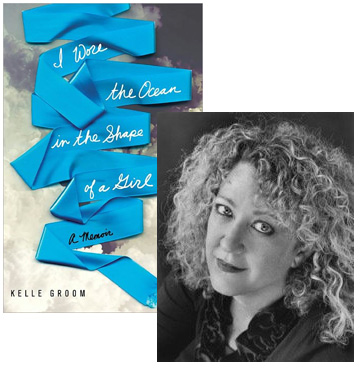Kelle Groom & the Discovery of Compassion

In a early chapter of her memoir, I Wore the Ocean in the Shape of a Girl, Kelle Groom describes herself as a “ghost mother.” She’d surrendered her son to her aunt and uncle shortly after his birth, knowing that her alcoholism had already gotten to the point where she was unable to provide the care he needed. When he died of leukemia just a few years later, her own life began to deteriorate as well. As the memoir reveals, getting sober was only part of the answer… and when, years later, Groom started to write about what happened, she found that the journals she’d written back then were little help: “Reading about myself,” as she writes in this guest essay, “was like watching someone drown.” It was only by starting over, and looking at her younger self from a completely fresh perspective, that she was able to find the story she sought—but also something more.
When I think about the driving forces behind the writing of my memoir, I remember the first pieces I wrote—journal entries that began in 1979 and ran through the mid 1990s. I always wrote at night, when things quieted. When I wrote—though no one ever read my journals—I always felt heard. I became myself in a way I couldn’t in my daily life. At times, not writing was almost a kind of suffocation.
When I was 20 years old, I began trying to write poems about some of the material in my memoir. Everything was so hidden in these poems. At 22, newly sober, I wrote both poems and stories that drew on the life I was living. By then, I was desperate for clarity, to be able to see what had happened. In my late twenties and early thirties, I wrote mostly poetry, and in those poems from my first collection, Underwater City, I began trying to find my son who had died in 1982. In these elegiac poems, and those in my second collection, Luckily, I also looked at the drinking that had so undermined me and the related violence—trying to see the girl I’d been and what happened to her.
In 2002, I had the idea of digging out those early journals and typing them up. I thought that they might reveal something and combined into a narrative, make a coherent whole. Instead, it was the opposite. While they were full of detail, the journals swamped me. There was simply no possibility for hope in them. Everything reduced to anecdote. Reading about myself was like watching someone drown. A fellow poet, Michael Burkard, who read that early “draft” suggested that I’d have to write it from the beginning. So, in 2006, I started over.
It was only in writing this story from the beginning, and seeing my younger self as a character, that I could access the clarity and compassion that I needed. I felt that by writing about my son, I could find him in whatever way was open to me. That is the force that drives my book. I Wore the Ocean in the Shape of a Girl is a lyrical memoir. I wanted the spaciousness of prose, but as Nathalie Sarraute said, “Poetry is what makes the invisible appear.” Through writing, I hoped to find a way into action in my own life, to take me to my son, and to find the lost girl I’d been.
There is the question of guilt that runs through the book. Who to blame for my son’s death. In the darkness of my early twenties, I’d felt unsalvagable. Ruined. I’d had the impulse to be torn into nothingness. To be punished for letting my son die. There is a chapter that takes place in a homeless shelter where I worked for three years. It’s a time and place where I feel nearly invisible, except to the children who live there, who reached out to me daily. It’s a joy to see them again in these pages.
Visual art is a source of beauty in the book, in paintings and in a statue of Guanyin, the Bodhisattva of Compassion, from AD 580 China, who has been standing in the Museum of Fine Arts, Boston since 1912. When I find her, I don’t yet know that she’s a mother too, a kind of Mary. I don’t know that’s she’s not going anywhere until no one is suffering. But I could feel her kindness. I can feel it from here. I don’t think I’d have found her without this book. The writing brought me to my son, and to her—this forgiving mother.
photo: Museum of Fine Arts
29 June 2011 | guest authors |

 Our Endless and Proper Work is my new book with Belt Publishing about starting (and sticking to) a productive writing practice.
Our Endless and Proper Work is my new book with Belt Publishing about starting (and sticking to) a productive writing practice. 
